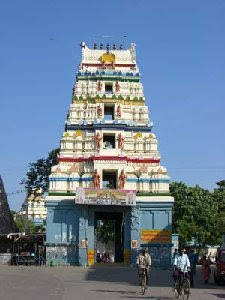Amaravati is a historic pilgrimage center and a storehouse of ancient Buddhist sculpture. Amaravati is home to the Amareswara temple which constitutes one of the five Pancharama temples of Andhra Pradesh sacred to Shiva, the other four being Kumararama (Kotipalli), Ksheerarama and Bheemarama and Draksharama. Amaravati is located about 15 miles away from Guntur near Vijayawada in Andhra Pradesh.
The temple of Lord Amareswara located on the banks of river Krishna, is rich in Dravidian and Buddist architectures. The Lingam is 15 feet high, carved out of marble. The city was named Amaravati after Indra's capital here. Tradition says that Indra and Devas had worshipped the Lord here. Goddess Shakthi is worshipped as Bala Chamundika Devi.
The white Linga is quite unique and the priests have to ascend the steps for offering abhishekam. As the name Amaravati implies, legend has it that Amaravati was once the abode of the Gods - the Devas, the yakshas and the kinnaras, who performed penances to Shiva to request him to rid the earth of the mighty demon Tarakasura.
Legend has it that Shiva's son Subramanya vanquished the demon. It is believed that the Shivalingam that shattered Into five pieces was a huge one, and the biggest of the five pieces is a fifteen foot long column of white marble which is worshipped as Amareswara at the Amaravati temple (this is very similar to the Shivalingam at the Draksharama temple). Legend has it that it was installed by Indra the king of the Devas, Brihaspati the guru of the Devas and Sukra the preceptor of the Asuras.
The Amaravati temple is located on a small hillock referred to as Krouncha Shaila, alongside the river Krishna which flows for a short distance in a North-Southerly direction, although for the most part, the river heads eastwards towards the ocean. The river Krishna is held in reverence at this pilgrimage site, and a ritual dip in this river here is considered to be meritorious.
The temple has ancient origins, however the structural foundations as seen today, seem to date back to the 11th century CE. The Vijayanagar kings did provide grants to maintain the temple. However it was the local kings of the 18th century CE that provided vast endowments to this temple. The temple is decorated with four lofty gopurams in its outer circumlocutory path.












Really nice post.At Amararama Temple, Lord Shiva is worshipped as Amaralingeswara Swamy.The Shiva idol is very Tall and has a red stain on top.
ReplyDeletealong with this beautiful temple there are a lot of beautiful places to visit in Guntur.